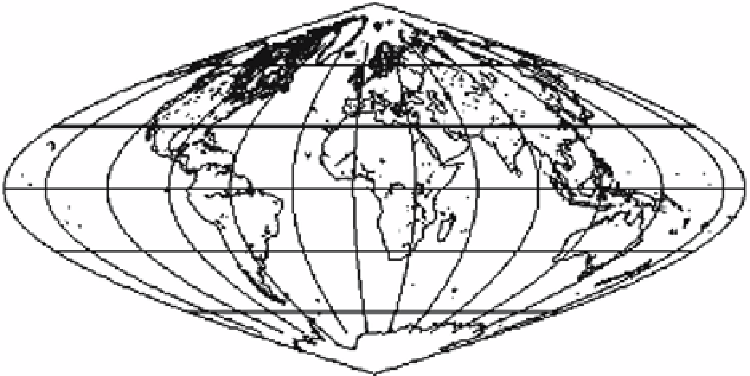Graphics Programs Reference
In-Depth Information
meridian. Because of the aspect ratio chosen by Mollweide, the central meridian is half
as long as the equator. The two meridians 90
◦
east and west of the central meridian
form a circle.
The mathematical expression of this projection starts with a point with longitude
θ
and latitude
φ
on the sphere. The point is mapped by this projection to the point
x
=
2
√
2(
θ
y
=
√
2sin
α
−
θ
0
)cos
α
π
and
on the map, where
θ
0
is the longitude at the center of the map and
α
is the solution to
the equation 2
α
+sin(2
α
)=
π
sin
φ
.
This projection is also called homalographic, homolographic (from the Greek
homo
,
meaning “same”), elliptical, or Babinet. There is also an interrupted version of the
Mollweide projection. Mathematically, this projection is pseudocylindrical equal-area.
This projection is sometimes used in thematic world maps. It preserves scale up
to latitude 40
◦
(north and south). North and south of this latitude, distortions become
more and more severe.
The sinusoidal projection (Figure 4.57), also known as the Sanson-Flamsteed pro-
jection and the Mercator equal-area projection, is the simplest pseudocylindrical equal-
area projection.
Figure 4.57: Sinusoidal Projection.
The width of a degree of longitude is proportional to the cosine of the latitude,
and the lines of latitude become straight segments placed uniformly on the map. This
combination preserves areas. Specifically, a point with longitude
θ
and latitude
φ
on
the sphere will be mapped by this projection to the point ((
θ
−
θ
0
)cos
φ, φ
)onthemap
(where
θ
0
is the longitude at the center of the map).




Search WWH ::

Custom Search